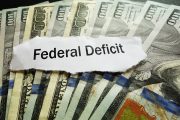
The Economic Report of the President, released on Thursday, touts the remarkable performance of the U.S. economy under the current administration. The good news is that the good news is likely to continue well on into the future.
Said the president, “Over the past three years my administration has championed policies to restore the United States’ economic strength, propelling growth to levels far exceeding preelection expectations.”
Those expectations were prepared by the Congressional Budget Office (CBO) just before the president was inaugurated, and the performance of the U.S. economy since then has beaten those projections every year since. For instance, the economy added more jobs last year than the CBO estimated would be created during the President’s entire first three years in office.
Nearly seven million jobs have been created nationwide, including 500,000 in the manufacturing sector. The unemployment rate reached its lowest rate in 50 years in 2019, and remains near that record low. Nearly 2.5 million Americans have been lifted out of poverty, while wages for the bottom 10 percent of earners are rising faster than for the top 10 percent. The net worth of the bottom half of U.S. households has increased by almost 50 percent in just the last three years. And the energy revolution is saving the average American family $2,500 a year in energy and transportation costs.
Thanks to the Tax Cuts and Jobs Act (TCJA), deregulation and the reduction in energy costs, the U.S. economy is now in its 11th year of expansion. The stock market continues to hit record highs while the number of IRA and 401(k) millionaires has hit all-time highs.
If the president’s report is right, the U.S. economy will likely continue to expand for years into the future.
More than 420 companies have signed the president’s Pledge to America’s Workers to create upwards of 14 million new jobs over the next five years. As President Trump noted in his introduction to the report, “The Federal Government does not create jobs; hardworking Americans create jobs. My Administration’s role is to follow our foundational policy pillars and allow our job creators and workers to do what they do best.”
One of those pillars is deregulation. When first announced, the policy was to remove two regulations for every new one enacted. Instead, said the president, “the Federal Government has cut more than seven regulations for every significant new regulation. After only three years, my Administration has already cut more regulations than any other in United States history, and we have put the brakes on an endless assault of new, costly actions by Federal agencies.”
And he’s just getting started: “My administration’s work is not yet done. With a continued focus on policies that increase economic growth, promote opportunity, and uplift our workers, there is no limit on how great America can be.”
Job one is to make his Tax Cuts and Jobs Act permanent, as most of the law’s provisions expire automatically on December 31, 2025. Unless the act is made permanent by Congress, American taxpayers will once again suffer under the high tax structure left over from the Obama administration.
For the present, said the report, “We expect near-term growth to be supported by the continuing effects of the TCJA, as well as new measures to promote increased labor force participation, deregulatory actions, immigration reform, reciprocal trade deals and an infrastructure program.”
Speaking of reciprocal trade deals, the report notes that the administration’s ultimate goal is “freer, fairer trade, with zero tariffs, zero nontariff barriers, and zero subsidies [by governments to support particular industries].”
The report speaks of “tax reform that incentivizes investment in human capital, regulatory reform that eliminates prohibitive barriers to entry for more innovative and entrepreneurial firms, and health investments and labor market policies that facilitate human capital accumulation [that] may … yield higher-growth dividends than those estimated here.”
The key to continued growth of the U.S. economy, according to the president’s report, will be “higher output per hour worked.… We expect enactment of corporate tax reform to considerably increase capital per worker, and thus labor productivity.”
The report also issued a warning, namely, that all of the progress could be stalled or reversed by a recalcitrant or opposition-obsessed Congress: “A key downside risk is in scenarios where future administrations or Congress partially or fully reverse the TCJA, otherwise raise taxes, or significantly expand the Federal regulatory state.”
Having issued that warning, the report concludes that the economy is expected to continue to grow at three percent a year. Under the “rule of 72,” that means that in 24 years the country’s gross domestic product (GDP) will be more than $40 trillion a year and the Dow Jones Industrial Average will be trading at 60,000.
Even that may understate the coming reality, as the report said nothing about the president’s plan to roll out Tax Cuts and Jobs Act 2.0 in September, just in time for his reelection in November.
Image: honglouwawa via iStock / Getty Images Plus
An Ivy League graduate and former investment advisor, Bob is a regular contributor to The New American, writing primarily on economics and politics. He can be reached at [email protected].
Related articles:
ADP Says 291,000 New Jobs in January; It’s More Like 336,000



